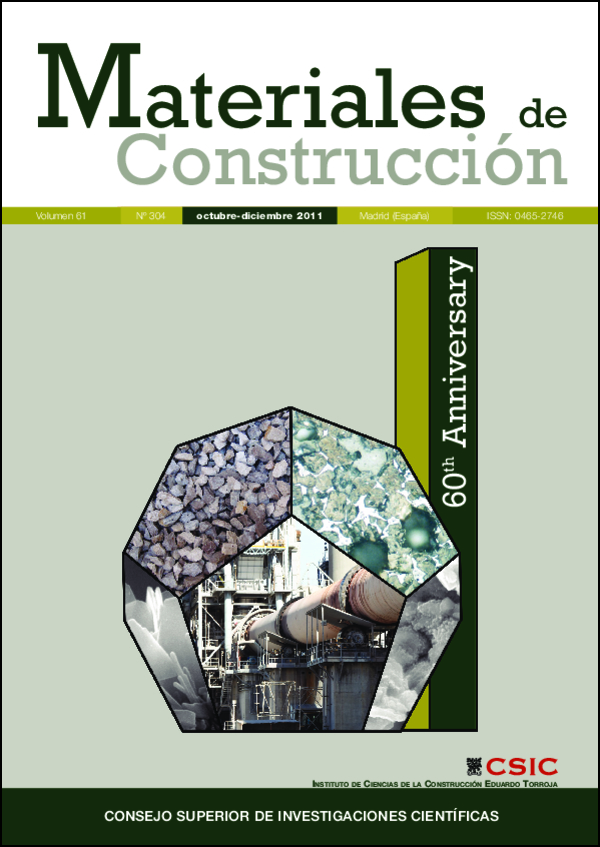Pathologies and analytical study of mosaic materials from Carmona and Italica
DOI:
https://doi.org/10.3989/mc.2011.64310Keywords:
Tesserae, Glass, Mortar, Roman, DeteriorationAbstract
This work reports on the characterization of Roman mosaic samples from Carmona and Italica (Spain). A physico-chemical study of both glass tesserae and mortar fragments to determine their composition, to evaluate their state of conservation and to study their production technology was carried out. Samples were characterized by means of a binocular microscope, SEM-EDS, visible spectrophotometry, XRD and petrographic analysis. The tesserae were made from soda lime silicate glass, even though one of them showed high contents of lead and copper oxides. The samples from Carmona showed deterioration pathologies associated to the humidity affecting the mosaic during burial, while those from Italica presented traces of biodeterioration. The data also indicated that the glass used in the tesserae had a lower technical quality than that used in tableware pieces of similar chronology.
Downloads
References
(1) Carrascosa Moliner, T.: La conservación y restauración del mosaico, Universidad Politécnica de Valencia, Valencia, (2004).
(2) Dunbabin, K. M. D.: Mosaics of the Greek and Roman World, Cambridge University Press, New York, (1999).
(3) Blázquez, J.M. El mosaico romano en Hispania. http://www.cervantesvirtual.com/FichaObra.html?Ref=21223&portal=114
(4) Ramallo Asensio, S.: "Talleres y escuelas musivas en la Península Ibérica" en Mosaicos Romanos. Estudios sobre iconografía, Asociación Española del Mosaico, Guadalajara, (1990).
(5) García y Bellido, A.: Andalucía monumental. Itálica, Editoriales Andaluzas Unidas, S.A., Sevilla, (1985).
(6) Garcia-Rowe, J., Saiz-Jimenez, C.: "Colonization of mosaics by lichens: the case study of Italica (Spain)", Studia Geobotanica, Vol. 8 (1988), pp. 65-71.
(7) Saiz-Jimenez, C., Garcia-Rowe, J., Rodriguez-Hidalgo, J. M.: "Biodeterioration of polychrome Roman mosaics", International Biodeterioration, Vol. 28 (1991), pp. 65-79. http://dx.doi.org/10.1016/0265-3036(91)90034-O
(8) Puertas, F., Blanco-Varela, M. T., Palomo, A., Ortega-Calvo, J. J., Ariño, X., Saiz-Jimenez, C.: "Decay of Roman and repair mortars in mosaics from Italica, Spain", The Science of the Total Environment, Vol. 153 (1994), pp. 123-131. http://dx.doi.org/10.1016/0048-9697(94)90109-0
(9) Ariño, X., Gomez-Bolea, A., Saiz-Jimenez, C.: "Lichens on ancient mortars", International Biodeterioration & Biodegradation, Vol. 40, nº 2-4 (1997), pp. 217-224. http://dx.doi.org/10.1016/S0964-8305(97)00036-X PMCid:373060
(10) Tite, M., Pradell, T., Shortland, A.: "Discovery, production and use of tin-based opacifiers in glasses, enamels and glazes from the Late Iron Age onwards: a reassessment", Archaeometry, Vol. 50, nº 1 (2008), pp. 67-84.
(11) Ricciardi, P., Colomban, P., Tournié, A., Macchiarola, M., Ayed, N.: "A noninvasive study of Roman Age mosaic glass tesserae by means of Raman spectroscopy", Journal of Archaeological Science, Vol. 36, nº 11 (2009), pp. 2551-2559. http://dx.doi.org/10.1016/j.jas.2009.07.008
(12) Foster, H. E., Jackson, C. M.: "'A whiter shade of pale'? Chemical and experimental investigation of opaque white Roman glass gaming counters", Glass Technology, Vol. 46, nº 5 (2005), pp. 327-333.
(13) Rincon, J. M., Blanco, M. T., Sanchez-Rojas, M. I., Romero, M.: "Colours from the glazed tiles inserted in the Blaster Mudejar façade of Pedro I, Sevilla Royal Palaces" en COLOURS 2008: Bridging Science with Art, Universidade de Evora, Evora, (2008).
(14) Fernández Rodríguez, J. M., Fernández Fernández, J. A.: "Caracterización físicoquímica de los morteros romanos de El Ruedo (Almedinilla, Córdoba)", Materiales de Construcción, Vol. 54, nº 275 (2004), pp. 39-51.
Downloads
Published
How to Cite
Issue
Section
License
Copyright (c) 2011 Consejo Superior de Investigaciones Científicas (CSIC)

This work is licensed under a Creative Commons Attribution 4.0 International License.
© CSIC. Manuscripts published in both the print and online versions of this journal are the property of the Consejo Superior de Investigaciones Científicas, and quoting this source is a requirement for any partial or full reproduction.
All contents of this electronic edition, except where otherwise noted, are distributed under a Creative Commons Attribution 4.0 International (CC BY 4.0) licence. You may read the basic information and the legal text of the licence. The indication of the CC BY 4.0 licence must be expressly stated in this way when necessary.
Self-archiving in repositories, personal webpages or similar, of any version other than the final version of the work produced by the publisher, is not allowed.
















